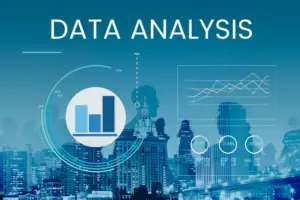Why Data Analytics Is Indispensable Today
In the modern business world, data is the decisive factor between success and failure. Companies that make data-driven decisions enjoy clear advantages: they detect trends earlier, optimize processes, and use resources more efficiently. Those who rely solely on gut feeling and experience risk missing opportunities or making costly mistakes. But what exactly is behind data analytics? What methods are there, and how can companies use them effectively? In this article, you’ll learn how data analytics is reshaping business strategies and what role Artificial Intelligence (AI) plays in the process.
The Four Types of Data Analysis
Not all data analyses are the same. Depending on the goal and the question at hand, different methods are used:
1. Descriptive Analysis: Looking into the Past
Descriptive analysis helps companies better understand past developments. Data is collected and presented in the form of reports, dashboards, or visualizations. This makes it possible to identify patterns and draw initial conclusions for the future.
Example: An online store analyzes sales figures from the past few months and discovers that certain products sell particularly well during specific seasons. This insight helps with inventory planning.
2. Predictive Analysis: What the Future Might Hold
This is where statistics come into play. Using machine learning and historical data, predictive analysis creates approximate forecasts for future developments.
Example: A streaming provider analyzes its users’ viewing habits and can roughly predict which films and series will be especially popular. Based on these insights, the company invests strategically in new productions.
3. Prescriptive Analysis: Making the Best Decisions
Prescriptive analysis goes a step further. It not only predicts potential trends but also derives concrete recommendations for action. Advanced algorithms and AI are often used here.
Example: A logistics company uses AI to optimize delivery routes in real time. As a result, delivery times are shortened, and costs are reduced.
4. Diagnostic Analysis: Understanding the Causes
Why did something happen? This is the question diagnostic analysis seeks to answer. It examines relationships and helps companies identify the factors behind success or failure.
Example: An e-commerce company notices that its website’s conversion rate has dropped. A detailed analysis reveals that a new checkout process is discouraging customers. The company adjusts the design, and sales figures rise again.

The Benefits of Data-Driven Decisions
Companies that leverage data analytics benefit in multiple ways:
More Efficient Operations
Data helps identify bottlenecks and optimize processes. This increases productivity and reduces costs.
Better Customer Insights
Understanding customers allows companies to respond more precisely to their needs. Data analytics enables personalized marketing strategies and improves customer satisfaction.
Optimized Risk Management
Whether it’s cyberattacks or market fluctuations, predictive analytics allows companies to detect risks early and take proactive action.
Greater Competitive Advantage
Faster, well-informed decisions give businesses an edge over their competitors.
Artificial Intelligence as a Game-Changer
AI is transforming the way data is analyzed. Algorithms can process vast amounts of information in a fraction of the time and detect patterns that would be nearly invisible to the human eye.
Examples of AI-powered analytics:
- Chatbots that automate customer support
- AI-driven market analysis to predict consumer trends
- Automated fraud detection in the financial sector
The share of AI in data analytics is growing rapidly and already accounts for 15–20% in many companies. This percentage is expected to rise further in the coming years.
Challenges in Implementation
Despite all the benefits, there are still obstacles on the path to becoming a data-driven organization:
Data quality: Incomplete or inaccurate data leads to false conclusions.
Data protection : Companies must ensure that sensitive information is safeguarded.
Talent shortage: Skilled data analysts are in high demand and often difficult to find.
Integration into existing systems: Connecting analytics solutions to existing IT infrastructure can be challenging.
How to Ensure Successful Implementation
To make the most of data analytics, companies should follow these steps:
- Establish a data culture: Employees need to understand why data is important and how it can be used.
- Choose the right tools: Whether it’s Google Analytics, Tableau, or Power BI, the right tool is crucial.
- Connect data sources: Comprehensive analysis is only possible when different data sources are combined.
Where Is the Journey Heading?
The field of data analytics is evolving at a rapid pace. Key trends include:
AI and machine learning: Ever more powerful algorithms enable even more accurate analyses.
Real-time analytics: Businesses can respond instantly to market changes.
Big Data and cloud computing : The growing volume of data requires flexible, scalable solutions.
Improved visualization tools: Interactive dashboards make it easier to interpret complex data.

Conclusion
Data analytics is no longer optional—it’s a necessity for any successful business. It helps organizations make better decisions, optimize processes, and remain competitive in the long term. Those who invest in data and AI have the best chance of staying ahead of the competition. Now is the perfect time to start thinking data-first and set the course for the future.
FAQs
1. How does data analytics help with business decisions?
Data analytics enables companies to identify trends, minimize risks, optimize processes, and make informed forecasts about future developments.
2. What are the main types of data analysis?
The most important types include:
- Descriptive analysis – Analyzing past data
- Predictive analysis – Making approximate forecasts about future developments
- Prescriptive analysis – Deriving actionable recommendations
- Diagnostic analysis – Identifying the causes behind certain developments
3. Which industries benefit most from data analytics?
While data is valuable in virtually every sector, some industries gain particularly strong advantages where large volumes of information can be collected and decisions made based on it:
- Retail: Analytics helps understand customer buying behavior, create targeted offers, and manage inventory efficiently.
- Healthcare: By evaluating patient data, doctors can make more accurate diagnoses, develop personalized treatment plans, and improve resource allocation in hospitals.
- Industry & manufacturing: Companies use data to predict equipment maintenance needs (predictive maintenance), streamline production processes, and reduce costs.
- Education: Schools and universities leverage analytics to personalize learning, improve student outcomes, and optimize administrative processes.
Overall, organizations that use data effectively can make better-informed decisions and achieve long-term success.
4. What challenges exist when implementing data analytics?
As promising as data analytics is, introducing it often comes with hurdles:
- Data quality: Incomplete or inaccurate information can distort results.
- Technical barriers: Existing IT systems aren’t always compatible with new analytics tools, making smooth integration complex.
- Talent shortage: Skilled data professionals are in high demand and not always easy to find. Without the right expertise, much of the potential of data remains untapped.
- Data protection and security: Companies must comply with legal requirements and protect sensitive data from misuse.
Organizations that address these challenges can successfully embed analytics into their operations and unlock valuable insights.
5. What future trends can we expect in data analytics?
The way we analyze data is constantly evolving. Key trends already emerging include:
- Real-time analysis: Instead of reviewing data after the fact, companies will increasingly be able to react instantly to new developments.
- AI-powered analytics: Artificial Intelligence will detect patterns in data and generate forecasts automatically.
- Cloud technologies: More organizations will rely on cloud-based solutions to store and process large volumes of data efficiently.
- Improved visualization tools: Data will not only be analyzed accurately but also presented in a clear, accessible way so that everyone in the company can benefit.
The future of data analytics will likely bring faster, more accurate, and more accessible solutions—helping companies make even better decisions.




